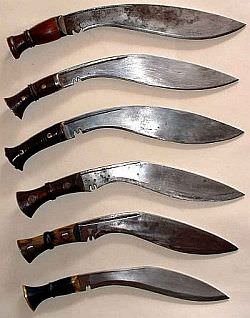Gurkha''s at kit inspection showing kukris
Beyond the Knife: The kukri is also much more than just a knife or a weapon because of its religious values it carries and beliefs it has created. The shape of the blade itself represents the trinity symbols of Brahma, Vishnu and Shiva, the three most famous and influential Hindu Gods.
It is also worshipped on different occasions and festivals mainly in Dashain, where it is put into action beheading animals as offerings to the Durga goddess (Goddess who slaughtered devils and evil).
Similarly in Biswakarma Puja, devotees worship it along with other iron and steel tools to pay their respect and loyalty. Why during sacrificial ceremonies? There is a belief in Nepalese society that it must taste blood to become a kukri. This sacrificial tradition follows in the Gurkha Army where each year animals are sacrificed to foresee good fortune and blessings to the regiments and its soldiers.
The faith and belief that the kukri has produced are remarkable and interesting. A kukri when kept at home would bring fortune, prosperity and kill evil spirits. It is believed to have spiritual power to scare off demons, evils and nightmares and thus kept under the pillow of a man or even a child who suffers from a sleeping disorder.
Similarly in Mongolian ethnic groups a man would have his kukri cremated along with him in a belief that the kukri would defeat Satan so that the departed soul could go to heaven and rest in peace.
A man with a khukuri represents a man of honor, dignity, courage and loyalty who would kill and get killed for the right cause. Padma Shamsher Jung Bahadur Rana, former Prime Minister of Nepal stated it was the national as well as religious weapon of the Gurkha, so it should be carried while awake and placed under the pillow when retired.
Finally, the oldest kukri known to exist is the one on display at the National Museum in Kathmandu which belonged to Drabya Shah, the King of Gorkha in 1627 AD. It is, however, certain that the origins of the knife stretch further back, perhaps 2500 years.



